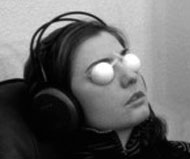
Last year I was in Unna, Germany, encountered this work by James Turrell, inspired by Ganzfeld and felt a little betrayed, because I wanted to make something like that; sometime before I got inspired by a snowy landscape. The work was very intruiging though. So today I started searching on how to create such an effect in different ways. I also encountered the work Zee by Kurt Hentschlaeger: a space full of dense fog with stroboscopic light. It was exposed on STRP a couple of years ago, and while I was there at the time, I remember it being closed for the day. Anyway, today I found out it all traces back to the Ganzfeld effect that I just experienced.

From Wiki:
In the 1930s, research by psychologist Wolfgang Metzger established that when subjects gazed into a featureless field of vision they consistently hallucinated and their electroencephalograms changed.
The Ganzfeld effect is the result of the brain amplifying neural noise in order to look for the missing visual signals. The noise is interpreted in the higher visual cortex, and gives rise to hallucinations. This is similar to dream production because of the brain's state of sensory deprivation during sleep.
The Ganzfeld effect has been reported since ancient times. The adepts of Pythagoras retreated to pitch black caves to receive wisdom through their visions[2], known as the prisoner's cinema. Miners trapped by accidents in mines frequently reported hallucinations, visions and seeing ghosts when they were in the pitch dark for days. Arctic explorers seeing nothing but featureless landscape of white snow for a long time also reported hallucinations and an altered state of mind.
The effect is a component of a Ganzfeld experiment, a technique used in the field of parapsychology.
The artist James Turrell (partly inspired by clear blue skies) has created many such "Ganzfelds" throughout his oeuvre.
Geen opmerkingen:
Een reactie posten